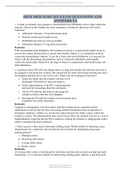Human Physiology An Integrated Approach 8th Edition (Silverthorn)
Test Bank Complete_
Human Physiology An Integrated Approach 8th Edition,
Dee Unglaub Silverthorn Latest Update 2024 (All Chapters 1-26)
8Th Edition
,Human Physiology An Integrated Approach 8th Edition (Silverthorn)
Table of Contents
PART I. BASIC CELL PROCESSES: INTEGRATION AND COORDINATION ....................... 3
Chapter 1: Introduction To Physiology ............................................................................................... 3
Chapter 2: Molecular Interactions..................................................................................................... 13
Chapter 3 Compartmentation: Cells And Tissues ............................................................................. 24
Chapter 4 Energy And Cellular Metabolism..................................................................................... 77
Chapter 5 Membrane Dynamics ..................................................................................................... 101
Chapter 6 Communication, Integration, And Homeostasis ............................................................ 136
PART II. HOMEOSTASIS AND CONTROL ............................................................................... 158
Chapter 7 Introduction To The Endocrine System ......................................................................... 158
Chapter 8 Neurons: Cellular And Network Properties ................................................................... 176
Chapter 9 The Central Nervous System .......................................................................................... 219
Chapter 10 Sensory Physiology ...................................................................................................... 243
Chapter 11 Efferent Division: Autonomic And Somatic Motor Control ........................................ 295
Chapter 12 Muscles......................................................................................................................... 318
Chapter 13 Integrative Physiology I: Control Of Body Movement ................................................ 351
PART III. INTEGRATION OF FUNCTION ..................................................................................... 370
Chapter 14 Cardiovascular Physiology ........................................................................................... 370
Chapter 15 Blood Flow And The Control Of Blood Pressure ........................................................ 427
Chapter 16 Blood ............................................................................................................................ 461
Chapter 17 Mechanics Of Breathing ............................................................................................... 496
Chapter 18 Gas Exchange And Transport....................................................................................... 532
Chapter 19 The Kidneys ................................................................................................................. 558
Chapter 20 Integrative Physiology II: Fluid And Electrolyte Balance ........................................... 582
PART IV. METABOLISM, GROWTH, AND AGING ..................................................................... 609
Chapter 21 The Digestive System ................................................................................................... 609
Chapter 22 Metabolism And Energy Balance................................................................................. 639
Chapter 23 Endocrine Control Of Growth And Metabolism .......................................................... 679
Chapter 24 The Immune System ..................................................................................................... 710
Chapter 25 Integrative Physiology III: Exercise ............................................................................. 747
Chapter 26 Reproduction And Development .................................................................................. 767
,Human Physiology An Integrated Approach 8th Edition (Silverthorn)
PART I. BASIC CELL PROCESSES: INTEGRATION AND COORDINATION
Chapter 1: Introduction To Physiology
Multiple Choice.
1) Physiology Is The Study Of
A) The Structure Of The Body.
B) The Tissues And Organs Of The Body At The Microscopic Level.
C) Growth And Reproduction.
D) The Normal Functions Of The Organ Systems.
E) The Facial Features As An Indication Of Personality.
ANS: D
Rationale: Physiology Focuses On The Functions Of Organ Systems.
A) Anatomy Studies Structure, Not Function. B) Microscopic Analysis Relates More To Histology.
C) While Growth And Reproduction Are Physiological Processes, They Are Not The Focus Of The
Field As A Whole.
E) This Relates To Psychology, Not Physiology.
2) The Literal Meaning Of The Term Physiology Is Knowledge Of
A) Organs.
B) Nature.
C) Science.
D) Chemistry.
E) Math.
ANS: B
Rationale: "Physiology" Derives From Greek, Meaning "Knowledge Of Nature."
A) Organs Relate To Anatomy, Not The Broader Scope Of Physiology.
C) Science Is A General Term; Physiology Is A Specific Branch.
D) Chemistry Is Part Of Physiology But Does Not Encompass Its Meaning.
E) Math Is Unrelated To The Term.
, Human Physiology An Integrated Approach 8th Edition (Silverthorn)
3) Because Anatomy And Physiology Have Different Definitions, They Are Usually Considered
Separately In Studies Of The Body.
A) True
B) False
ANS: A
Rationale: Anatomy (Structure) And Physiology (Function) Are Distinct Fields, Typically Studied
Separately.
B) While They Are Interrelated, Their Definitions Warrant Separate Consideration.
4) The Correct Order From The Smallest To The Largest Is
A) 2, 4, 1, 3, 6, 5.
B) 4, 2, 1, 6, 3, 5.
C) 4, 2, 1, 3, 6, 5.
D) 4, 2, 3, 1, 6, 5.
E) 6, 4, 5, 2, 3, 1.
ANS: C
Rationale: The Correct Order Is Molecule (4), Cell (2), Tissue (1), Organ (3), Organ System (6),
Organism (5).
A) Incorrect Order;
B) Places Organ System Before Organ.
D) Incorrect Sequence;
E) Incorrectly Lists Organism First.
5) This Type Of Explanation Is
A) Mechanistic.
B) Theological.
C) Teleological.
D) Metalogical.
E) Scatological.
ANS: C
Rationale: Teleological Explanations Focus On The Purpose Or Function Of Processes.
A) Mechanistic Would Describe How Glucose Is Transported, Not Why.





